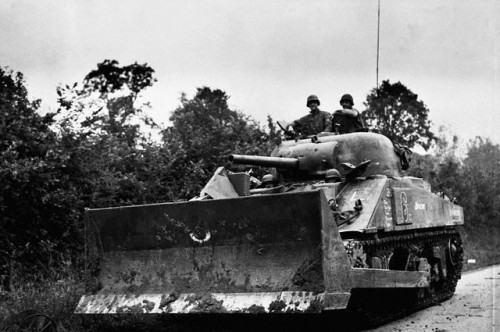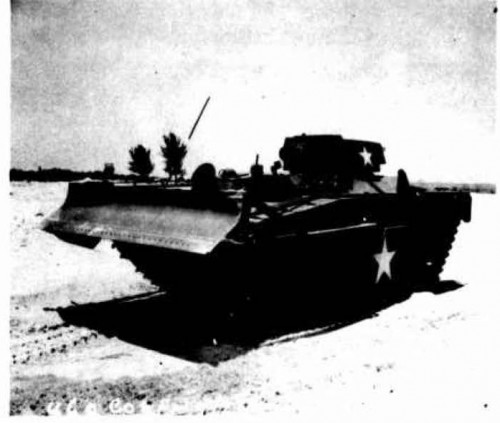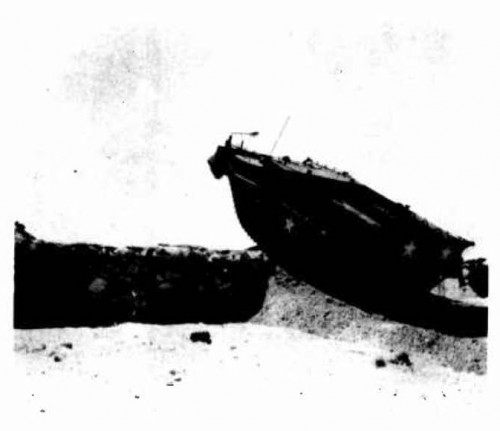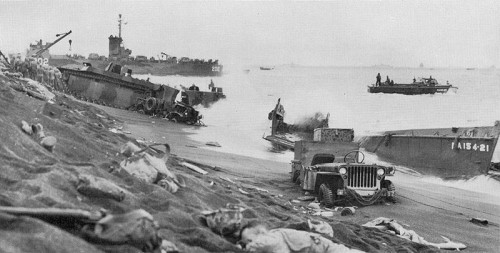One of the focal points in my writing these History Friday columns has been trying to answer the question “How would the American military have fought the Imperial Japanese in November 1945 if the A-bomb failed?” Today’s column returns to that theme by examining one of many “reality lives in the detail” changes in material, training and doctrine that the US Army was making for the invasion of Japan. Details that have been overlooked by historians of that era, mainly because the people involved really were not interested in their failures being exposed in the historical narrative. The failure I am referring to in this column is “Tentative Specification, Engineering Board Project No. 855, Bulldozer, Rigid, Landing Vehicle, Tracked, LVT Series.” A bulldozer kit that could turn any amphibious tractor or tank into a amphibious bulldozer. And how US Army politics and procurement priorities in developing and deploying this kit denied the US Marine Corps a vital tool that could have easily saved hundreds of lives in the first days of the assault upon Iwo Jima, and rendered a potentially very useful weapon into an obscure footnote in even the most detailed histories of WW2.**

HISTORICAL BACKGROUND
Theoretically the US Army Corps of Engineers and Ordnance, like all US Army branches, were abolished for the duration of World War 2 (WW2) and their functions were placed inside a “Army Service Force” (ASF). The Infantry, Cavalry and Artillery “Combat Branches” were similarly abolished and moved into the “Army Ground Forces” (AGF). The reality, however, was different. All that really changed for the branch bureaucrats were titles and institutional reporting channels. The US Army Corps of Engineers and Ordnance procurement pretty much existed as before with a lot more money to spend and just as before the combat branches got to comment after projects were “thrown over the wall” between ASF and AGF. This affected many decisions made as pre-war ideas of “bureaucratic turf” were only minimally affected by the additional money. One of these areas of turf war was the development of the M4 Sherman Tankdozer, one of the few armored engineer vehicles or “Funnies” the US Army developed in WW2.

Major Karl F. Eklund, who supervised the Mechanical Equipment Section at the Engineer Board, pushed ahead with the tankdozer development despite no clear military requirement from the using arms. Eklund and the board’s project engineer, William J. Murwin worked with the Caterpillar Tractor Company and two industrial producers of tractor blades — the LeTourneau and LaPlante-Choate Companies — experimented with mounting various blades on tanks. They managed to get a few kits to Italy in time for the fighting in the Spring 1944 Italian offensives. Their success drew requests from General Eisenhower for over 350 for the invasion of France. See this link for a detailed M4 Tankdozer history:
Development of the M4 Sherman Bulldozer Tank in World War II
AMPHIBIOUS TANKDOZER STARTS WELL…
This M4 Tankdozer success also drew the interest of the US Marine Corps through the instrument of the Joint Army-Navy Experimental and Testing Board (JANET) at Fort Pierce, Florida. Whose job was to complete projects that worked under “Program for Development Under Project DM 460, Passage of Beach and Underwater Obstacles, through June 1944.” JANET and the Engineering Board between May and August 1944 executed development project “ME 495,” titled “Dozer Attachment for LVT” the end result of which was the “Landing Vehicle, Tank, Armored, Mark I,” or simply LVT(A)1, pictured above. It was a cable powered blade design from R. G. LeTourneau and in it’s Florida testing it showed showed the following obstacle reduction performance:
a. Japanese Log Wall. A log wall, 4-feet in height, was breached in 1 minute 20 seconds.
.
b. Japanese Coral Wall. This obstacle was negotiated in 2 minutes 15 seconds,
.
c. Stump Wall, The stump wall, 6 feet in height and backed up by sand, was negotiated in 7 minutes 30 seconds
.
d. Japanese Scaffolding. Afloat, three tries taking 6 minutes 30 sec. Awash with ground traction, 1 minute 30 seconds. Low tide exposed, 1st try in seconds
.
e. Jetted Steel Rails. Afloat, failed. Low tide exposed, seconds in stride
.
f. Concrete Coffins. Could move individual coffins, incapable of making a road through a pattern.
.
g. Concrete Cylinders. Could move individual Cylinders. Marginally capable of making a road through a pattern of cylinders with immediate clutch mortality issues.
.
h. Steel and Concrete Tetrahedrons on a beach. Removed without difficulty in two-to-three passes.
.
i. Steel Tetrahedrons in shallow water. Moved with difficulty with an observer on the bow signaling the driver.
All of that at the price of being 1/2 knot slower in water. By the objectives set by JANET and the Engineering Board, the project was a raging success in early August 1944 and required immediate production. It didn’t turn out that way.
AMPHIBIOUS BULLDOZER HITS A BUREAUCRATIC WALL
Another prototype LVT(A)1 was immediately shipped to the Landing Vehicle Board test site at Ft. Ord California, where the 18th Armored Group trained Amphibious Tank and tractor Battalions for the US Army in the Pacific.
There a very different user perspective threw cold water all over the “LVT Dozer” project in September 1944:
In the opinion of this Board, clutch overheating is only the preliminary to major difficulties, and complete clutch failure should be expected within a very short period of operation. This period would vary from a few minutes to a maximum of possibly six (6) hours, depending upon the work attempted and the skill of the operator.
and
Subject attachment is a special engineer tool similar in application to the “Engineer Tank” and should not be issued to amphibian tank or tractor units. These units have neither training time nor background for complete utilization of whatever potentialities subject attachment may have.
Landing Vehicle Board had real points here. The early LTV-1 had a 200 hour lifetime and later LVTs, whether tank or tractor, only has a 600 hour lifetime under normal operating conditions before the engine and transmission had to be overhauled. Acting as a bulldozer was hugely outside its automotive design capabilities and required special training of the operators to last long enough to be useful. “Useful” being defined as the length of a amphibious operation.
The Landing Vehicle Board further requested that the Corps of Engineers provide the following:
a. Develop a “universal LVT dozer” kit.
b. Develop doctrine pertaining to its use.
c. Develop techniques of operation that don’t burn out clutches.
d. Establish a basis of issue to amphibious engineer assault units.
e. Work out the operation of the LVT Dozers in landing operations.
JANET, the contractor R. G. LeTourneau and the Engineering Board were all game and created the kit you see in the two photos below:

and

Then the project hit one more policy barrier that took the amphibious bulldozer kit completely out of World War 2. In January 1944 a Presidential directive giving the European Theater absolute priority in the US Army came into effect. When General Eisenhower staff were told of the LVT Dozer, they grabbed all of 50 kits existent at the time and sent them to…Italy.
The 50 kits and a training team arrived in Italy in March 1945 and as far as I have been able to determine, none concerned made it to Northern Italy for the 23 April 1945 Po Valley assault using LVT’s to overwhelm German Army positions there.
After VE-Day in May 1945, the kits and training team were rapidly returned to the USA by June 1945, and in late July 1945 a letter from the Engineering Board stated that R. G. LeTourneau was under contract and prepared to build another 114 more LVT Dozer Kits at a rate of 20 to 25 kits a week on a priority basis for the Pacific. There would have been 164 kits in the assault waves of Operation Olympic in November 1945.
LVT DOZERS & IWO JIMA
So what has this to do with the Feb 1945 Iwo Jima assault, as March 1945 in Italy is after and half a world away?
The fact R. G. LeTourneau could produce 20-25 Dozer kits a week in July-August 1945 doesn’t mean they could in late 1944-early-1945. Steel was in short supply in 1944-1945 and required clearance from the War Production Board. Many Pacific projects like US Army Chemical Warfare Service Flame tanks suffered from shortages of high hardness steel. R. G. LeTourneau would have been able to produce the Italy LVT Dozer kits only at a much slower basis over a much longer time. A production rate of something closer to 20 a month as opposed to 20 a week.
In addition, in WW2’s pre-Federal Express, pre-just-in-time inventory logistical world, the arrival of these kits in March 1945 Italy requires that they leave east coast US ports sometime in early February 1945. To put 50 dozer kits on ships by February 1945 would require R. G. LeTourneau to finish and package the last kits in January 1945 for rail transport. Some of the early production kits would have to be in the hands of the LVT Dozer engineer training team months earlier so contractors could train the team and write the user manuals.
A different priority for the first dozen or so LVT Bulldozer kits could easily have put them in Hawaii in January 1945, in time for loading for the Iwo Jima assault force with minimal training.
The difference that would have made can be seen in the photo below:

The huge first day casualty count on Iwo Jima was due to the incredible congestion that the black volcanic sand dunes caused on the beaches. This allowed Japanese artillery and especially mortars to pound the crowded beaches to great effect until bulldozers in later landing waves arrived and cut paths off the beach for tanks, trucks, LVT’s and other heavy equipment.
A dozen LVT Dozers in the first wave at Iwo Jima, even with ill-trained Marine LVT or Naval See Bee bulldozer operators who incapacitated their 12 LVT Dozers in an hour or less, would have cut dozens of sand dune beach exits in the first hour. This would have moved Marines out of the pre-registered artillery and mortar beach kill zones and made the beach a much less “target rich” environment. Easily 1/4 of the total casualties and half the combat deaths of the first day could have been prevented, but were not due to Army bureaucracy.
Thus we see yet again that the institutional narrative stories of success — the M4 Sherman tankdozer — told again and again. Meanwhile the hugely capable and highly useful LVT Dozer kit equivalents, which would have been as hugely important saving lives on the invasion beaches of Japan in the way that the M4 Sherman tankdozers did on Omaha Beach in June 1944, got buried so deeply in the historical record that those involved could avoid embarrassing questions that should have been asked, but weren’t.
Only by the power of modern internet search engines combined with someone willing to spend hours researching the question “How would the American military have fought the Imperial Japanese in November 1945 if the A-bomb failed?” do we know the story today.
**Text & source Update on 14 Oct 2013 to reflect an Osprey book I found in my home library after initial post.
Notes and Sources:
“Development of the M4 Sherman Bulldozer Tank in World War II” Accessed Sept 7, 2013
http://olive-drab.com/idphoto/id_photos_m4_sherman_bulldozer.php
Engineering Board Report 944 “THE UNIVERSAL LVT BULLDOZER ATTACHMENT” 63 pages 9 July 1945 DTIC Accession number ADB956956 accessed Sept 7, 2013
Eric Hammel, “IWO JIMA” Zenith Press, C 2006, ISBN-13: 978-0-7603-2520-9
Harold Icks, Col. AUSA(ret.) “LANDING VEHICLE TRACKED,” AFV Profiles 16, Profie Publications Ltd., U.K.
“Tankdozer” US Army Center of Military History Pamphlet, Accessed Sept 7, 2013
http://web.archive.org/web/*/http://publications.usace.army.mil/publications/eng-pamphlets/EP_870-1-42_pfl/c-3-2.pdf
Steven Zaloga, “AMTRACS US Amphibious Assault Vehicles,” New Vanguard 30, Osprey Books, C 1999
Pardon my French, but holy shit these posts are amazing, Trent. Thanks for sharing.
Love to read your articles. Surprising how little a person knows
about WWII History, even though one reads,quite alot about it.
Dan, Tom,
Bulldozer blades are not “sexy.”
Most logistical issues just aren’t, except when they fail and that can be made the goat for a failure in combat.
Consider the fact the LVTs 200-hour mechanical life time between overhauls the next time you read/hear about General Buckner’s failure to do an amphibious landing behind the Japanese lines on Southern Okinawa.
The USMC had used their LVT’s as personnel carriers in their drive north due to a TO&E lack of trucks. Later when the rains came to Okinawa in May 1945, the Marine LVTs were loaded with supplies daily, loaded on LST, and dropped off the Marines flanks to deliver supplies. The Marines were also using LVT Tractors extensively for medivac missions through the mud to the front lines.
These efforts used up the Marine LVT 200-hour life time such that by the time of the Naha landing the 6th Marine Division had to borrow 1/3 of the LVTs used in the landing from US Army LVT battalions because USMC LVT’s were mostly dead lined.
By the time the Japanese moved their covering Division away from the southern Okinawa beaches in May 1945, Buckner’s 10th Army lacked the “discretionary LVT landing capacity” to do a division sized landing and keep either that flanking division or the the front line artillery units supplied. It was one of the other, not both.
Buckner made the right choice.
As far as I’m concerned General Buckner had as much a lying historical narrative laid on him by the Navy as MacArthur did with the Southern Philippines.
Book!!
The Navy is the New York Yankees of bureaucratic knife-fighting and papering the historical file.
I just found the following:
HEADQUARTERS
755TH TANK BATTALION
APO 464
U.S. ARMY
REPORT
ON PREPARATION FOR AND EXECUTION OF
AMPHIBIOUS OPERATIONS
WITH THE BRITISH EIGHTH ARMY
ON LACK COMACCHIO, ITALY
http://755thtank.net/Operation_Impact.html
}}} Love to read your articles. Surprising how little a person knows about WWII History, even though one reads,quite a lot about it.
As he says, if you don’t go to first sources, you unfortunately don’t really know squat.
IGotBupkis,
I’m following a different methodology than most WW2 historians. One that requires a great deal more knowledge of the period and how people used the equipment and doctrine of the time.
It also requires more work and diligent fact checking.
Which is why these was a text update on a major fact and an addition to the sources and notes on the article today.
The Early LVT-1 Roebling tractor had a 200-hour life.
Later LVT tractors and tanks lasted 600 hours with their engine and transmission…but only _150-hours_ with their tracks. It was even shorter with extensive land use like the USMC did on Okinawa.
Trent,
You’ve probably come across this but it was new to me:
http://aviationtrivia.blogspot.com/2012/08/the-coming-kamikaze-threat-in-world-war.html
Trent, let me just add my voice to the chorus of “thank yous” for this series of posts that you are doing. I’m linking to some (so you can expect another 3 or 4 hits).
But I hope that you are putting this into a book. I’d pay cash money for a hardcover first edition.
L. C. Rees,
I have seen that site before and the narrative behind it long before I read it.
The issue with wood and canvas trainers was that they were dead meat in daylight for American fighters barring a huge saturation attack.
Night attacks with them required skilled pilots the Japanese were very short of and for which the standard US Navy tactic was to cover transport anchorages with night time smoke screens.
The Navy was taking a lot of steps, some of them pretty much lost on current historians, to deal with the threat both in terms of longer range weapons and adding planes that could shoot down Kamikazes.
Proximity fuses on aircraft rockets is but one example.
Another was the mass replacement of the battleship and cruiser single engine sea planes with the Curtiss SC-1 Seahawk for the Olympic invasion.
The SC-1 was armed with a pair of .50 cal HMG, had a max speed of 313 mph, could out-climb an F6F “Hellcat” to 6,000 ft. and could out-turn the F8F “Bearcat”. The SC-1 was faster than the Nakajima Ki-27 “Nate” and only 7 miles an hour slower than the Nakajima Ki-43 “Oscar.”
Think in terms of an American version of the A6M2 Zero based “Ruf” seaplane fighter.
The SC-1 would be able to intercept and shoot down wood and canvas bi-planes no sweat and tangle at low level with 2nd line and old front line Japanese Army fighters.
There would have been 150 of them in US Naval forces as follows —
U.S. Naval Forces Available for Olympic/Majestic with SC-1 (Via Norman Friedman)
FAST CARRIER TASK FORCE
14 CV
6 CVL
9 BB (4x SC-1 each)
2 CB (3x SC-1 each)
7 CA (2x SC-1 each)
12 CL (2x SC-1 each)
5 CLAA
75 DD
AMPHIBIOUS SUPPORT FORCES
12 CVE
11 BB (Older) (2x SC-1 each on nine OBB)
10 CA (2x SC-1 each)
15 CL (2x SC-1 each)
36 DD
6 DE
200 PT Boats [1]
LOGISTICS PROTECTION GROUP
10 CVE
1 CL (2x SC-1 each)
12 DD
42 DE
Curtiss SC Seahawk. Yet another plane I never heard of before.
Lex,
The Imperial Japanese Military was fighting with “Spirit”…and losing badly.
The American Military was fighting Materialsclacht all the way…and winning handily.
The Curtiss SC Seahawk was just another rapidly forgotten manifestation of that mismatch.